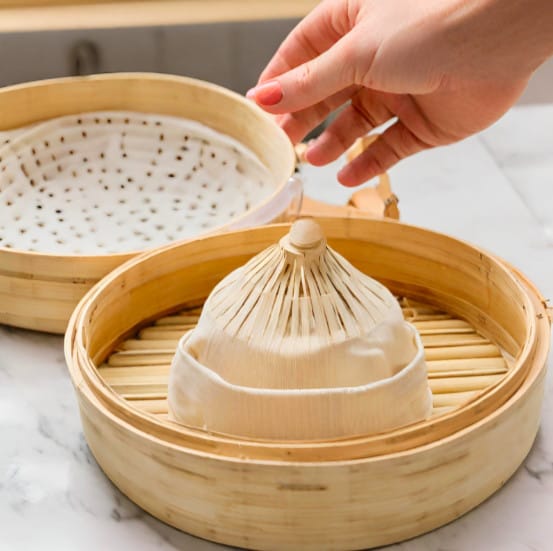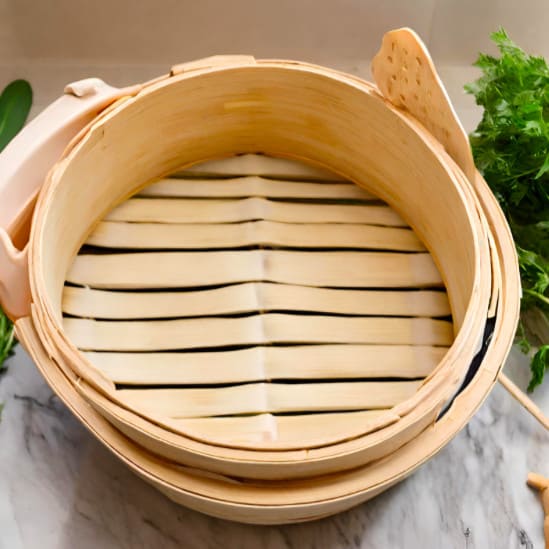
According to an expert, the key of using a bamboo steamer is to first line the bottom of each basket with parchment paper or cabbage leaves to prevent sticking. Then, arrange the food in a single layer, making sure to leave space between each item for steam to circulate. (1)
Now, it’s time to dive into the article!

KEY TAKEAWAY
How to Use Bamboo Steamer?
To use a bamboo steamer, begin by lining the trays with cabbage leaves or parchment paper to prevent sticking. Place the food items in a single layer, ensuring proper spacing for steam circulation, then stack the trays over a wok or pot of simmering water, allowing the bamboo steamer to gently cook the ingredients to perfection.
Choosing the Right Bamboo Steamer
When picking a steamer, consider how much food you need to cook at once. Large families do best with bigger stackable steamers that can prepare multiple layers of food simultaneously. Look for sturdy bamboo strips woven tightly together in a circle shape without large gaps. The bamboo should feel sturdy yet flexible so it can withstand hot cooking environments without cracking.
Pay attention to steamer dimensions too to ensure your pots will accommodate them. A good bamboo steamer will last for many years with proper care. Avoid very cheaply made models with thin bamboo that may break down faster with use. Checking reviews online can help you choose a high-quality steamer made to withstand regular steaming needs.
Preparing the Bamboo Steamer

Give your new steamer its first wash. Using mild dish soap and warm water, scrub any residue left from construction that may affect flavor. Getting off any dirt or chemicals is important before initial use. Rinse the steamer thoroughly under running water to remove all soap residue.
Allow the steamer to fully air dry away from direct sunlight before storing or cooking. This helps season and waterproof the natural bamboo for long-term use. Drying completely is important to prevent mildew growth in storage.
A well-prepared steamer will last much longer when initial cleaning removes impurities that could otherwise degrade the material over time.
Preparing the Food for Steaming
Many ingredients can be used for steaming such as napa cabbage, bok choy, carrots or shiitake mushrooms which pickup little flavor from steaming.
Perforated parchment, small plates or leaves are classic ways to hold ingredients and allow circulation. Leave a little space between items for optimal heat flow throughout the cooking process.
Cut foods into similarly sized pieces so they cook evenly. Denser foods like potatoes may need to be prepped smaller than softer items.
Arrange ingredients artistically if serving family style to make the plate visually appealing. Don’t overcrowd the steamer trays as this can lead to soggy or uneven results.
Setting Up the Steaming Environment
Bring water to a boil in a pot or pan that is wider than the bamboo steamer basket. This provides enough room for the steam to circulate without condensing back into water droplets. For foods that cook relatively quickly like chicken, use 1-2 inches of rapidly boiling water.
Longer cooking items like ribs or pork belly may require replenishing the water halfway through. Keep an eye on the water level so it doesn’t fully evaporate which could cause food to burn. Check the level every 10-15 minutes and top off with additional boiling water as needed. The pot should have a tight fitting lid to contain the steam.
Steaming Techniques
Most delicate foods like fish or dumplings only need 5-10 minutes under steam. Watch them closely towards the end of cooking time for visual cues like when skins become translucent. For heartier vegetables, meats or sandwiches, aim for 15-30 minutes depending on thickness.
Certain ingredients like sweet potatoes, taro or jicama that require longer cooking to become tender benefit from 40 minutes or more of steaming. Rotating trays halfway through allows for even cooking. Don’t overcrowd steamer baskets so steam can freely circulate.
Proper timing and spacing results in juicy, flavorful foods.
Preventing Food from Sticking
Lining steamer trays with damp cabbage, collard greens orbanana leaves provides a natural nonstick surface. Their flexible leaves contour to the shape of ingredients and block sticking. Cut leaf shapes slightly larger than food pieces for full coverage.
Parchment paper can also be used but may buckle or rip at high heat. Small plates are convenient but don’t fully prevent adhesion. Greasing the tray lightly with vegetable oil provides another option. The nonstick material should be removed before eating for healthiest steaming.
Proper preparation creates beautiful finished dishes.
Cleaning and Maintaining the Bamboo Steamer
After use, fill the steamer basket with soapy water and let it soak for 10-15 minutes. This softens any remaining foods or starchy residues. Use a soft bristle brush or cloth to gently scrub inner and outer surfaces. Avoid scouring which could damage the woven bamboo over time.
Rinse thoroughly and wipe dry completely with a lint-free towel. Storing in a dry place away from moisture is ideal. Periodically conditioning the interior and exterior bamboo with a light coating of food-grade oil helps maintain flexibility.
Proper cleaning and care allows your steamer to stand up to heavy usage while keeping a polished look.
Conclusion
In conclusion, incorporating a bamboo steamer into your cooking routine can open up a world of culinary possibilities. From steamed dumplings to fresh vegetables, the possibilities are endless.
So why not give it a try? I encourage you to share your experiences and recipes in the comments below. Happy cooking!
Frequently Asked Questions
How many tiers can a bamboo steamer have?
Bamboo steamers come in different sizes with varying numbers of tiers. Most home bamboo steamers contain two or three stackable steamer basket tiers, allowing you to cook multiple layers of food at once. Larger professional bamboo steamers used in restaurants may contain up to nine tiers.
What is the best way to line the steamer basket?
Cabbage leaves are often used to line steamer baskets as they are naturally non-stick. Other good options include perforated parchment paper, lotus leaves, or banana leaves. These materials help prevent food from sticking to the bottom of the steamer basket while still allowing steam to circulate.
How much water should be in the pot?
For most foods, you will need 1-2 inches of rapidly simmering water in the bottom of the pot. The water level should be checked periodically to maintain the level, usually every 10-15 minutes, adding more hot water as needed. Too little water can cause the food to burn before it finishes cooking.
What kinds of foods can be steamed?
Nearly any food can be steamed. Common items steamed in bamboo steamers include dim sum favorites like steamed buns, sticky rice, shumai and ha gao. Also popular are steamed vegetables, dumplings, cabbage, pork, and fish. Fruits such as bananas and Asian ingredients like lotus leaves are also often steamed.
How do I prevent food from sticking to the steamer basket?
Lining the steamer basket with non-stick materials like cabbage leaves, parchment paper or banana leaves before adding food helps prevent sticking. (2) Greasing the basket lightly with oil is another option. Avoid overcrowding which can cause foods to steam improperly and become soggy. Keeping ingredients in a single layer with space between also reduces sticking.
- You may like: How To Make Jars Airtight? Superb 3 Ways To Do It Easily
- You may enjoy this article about: Can You Open Oysters Without Oyster Knife? Superb 4 Guides To Do It
- This article may be interesting: Can A Refrigerator Leak Gas? Superb 5 Reasons Behind It That You Must Know
Was this helpful?

I’m Mary R. Q. , a seasoned professional chef dedicated to elevating home cooking experiences. Through my expertise in the culinary arts, I provide practical cooking tips and insightful reviews of kitchen utensils on my blog, milkwoodrestaurant.com. As a passionate advocate for transforming everyday meals into extraordinary culinary adventures, I aim to empower home cooks with the knowledge and tools they need to create delicious and memorable dishes. I’m also an author of the book “1,001 Kitchen Tips & Tricks: Helpful Hints for Cooking, Baking, and Cleaning (1,001 Tips & Tricks)” which is sold on Amazon. Join me on a flavorful journey as we explore the art of cooking and the essential tools that make it a joy.








